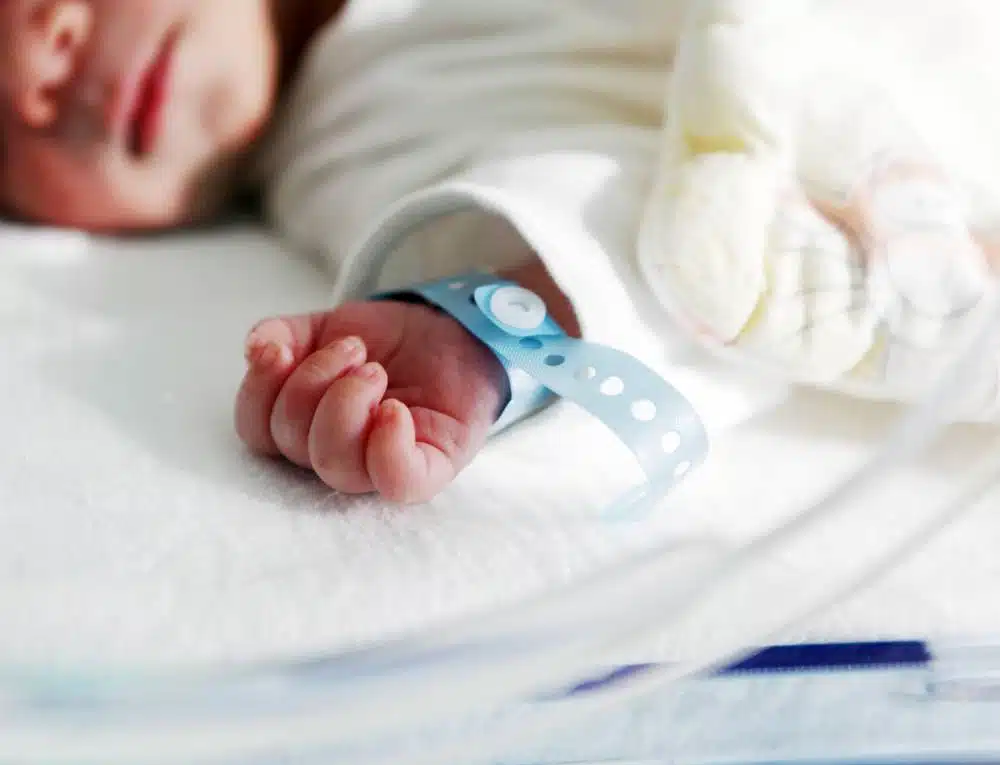
Content Reviewed by:
Dov Apfel
Content Reviewed by: Dov Apfel
Since 1979, Dov Apfel has been passionate about advocating for birth injury and medical malpractice victims. Mr. Apfel’s career-long record of achievements in birth injury litigation, education, and advocacy has been recognized by the Executive Board of the Birth Trauma Litigation Group of the American Association for Justice. His expertise is demonstrated by his numerous awards, presentations on birth injury topics at legal conferences for organizations like the AAJ and ATLA, and articles published by Trial Magazine and many others.
Recognizing cerebral palsy symptoms in your baby provides the opportunity for valuable early intervention. Although there is no cure for cerebral palsy, early treatment may reduce the long-term effects and lead to a higher quality of life for your child. The most important early sign of cerebral palsy is often an infant’s inability to reach developmental milestones at the appropriate ages.
Cerebral palsy is a cluster of movement disorders caused by abnormal brain development during pregnancy or brain damage during or shortly after birth. This condition often results from medical malpractice during prenatal care or childbirth. Children with cerebral palsy experience varying degrees of physical disability and have a higher risk of cognitive disabilities and seizure disorders.
The earlier cerebral palsy is diagnosed, the sooner the child can receive therapy to increase muscle control. Therapy and muscle training during infancy can prevent or reduce many of the complications associated with cerebral palsy, including muscle atrophy and abnormal bone growth.
Diagnosing cerebral palsy in infants requires a collaborative approach by alert parents and attentive doctors. Parents are generally the first ones to notice when something is wrong. If you have concerns that your baby is behind in meeting developmental milestones like rolling over, crawling, or walking, get your child evaluated for cerebral palsy or other developmental disorders.
Early Signs of Cerebral Palsy
There are four types of cerebral palsy, and they all present with different early symptoms. However, some symptoms are common to all of the types. The earliest general warning signs of cerebral palsy are often a baby’s inability to perform certain actions by the right ages, including the following:
- Head control by two months
- Rolling over by four months
- Sitting up unassisted by six months
- Walking by one year
Some children have mild cases of cerebral palsy that do not create noticeable developmental delays during infancy. You may notice these children have difficulties with fine motor skills as they reach toddlerhood or enter school. You also may notice abnormal difficulties with everyday tasks like dressing, buttoning clothes, or eating. As your child enters grade school, you may notice difficulties with writing.
In moderate or severe cases, you may notice symptoms specific to one of the four types of cerebral palsy during infancy.
Spastic Cerebral Palsy
Children with spastic cerebral palsy experience excessive muscle tone, which results in stiffness. This causes symptoms such as excess and constant bending at the joint, difficulty with movement, and pain due to contracture, or shortening of the muscles. In severe cases, movement of the affected muscles is impossible.
Spastic cerebral palsy is the most common form, affecting approximately 80 percent of those with the condition. The symptoms you may observe in a baby with spastic cerebral palsy will vary based on the muscle groups affected. Spastic cerebral palsy occurs as spastic hemiplegia, spastic diplegia, or spastic quadriplegia.
Spastic Hemiplegia
Spastic hemiplegia affects the arms and legs on one side of the body. One of the most important early symptoms of spastic hemiplegia during infancy is a noticeable hand preference. Children who develop normally are generally not right-handed or left-handed until at least 18 months.
Children with spastic hemiplegia will use their unaffected arm noticeably more often due to the difficulties caused by spasticity on the affected side. Your baby may always reach with the same hand, play using only one hand, or consistently hold one hand in a fist while holding the other in a normal position.
Other early signs of spastic hemiplegia during infancy include the following:
- Trouble with balance
- Difficulty walking
- An uneven gait
- Walking on the toes on the affected side
- Lopsided crawling, especially pushing off with one side while dragging the other
Spastic hemiplegia is most often diagnosed when the child is between ages 12 and 18 months of age.
Spastic Diplegia
Spastic diplegia affects both legs but not the arms. The most noticeable early sign of spastic diplegia is an unusual gait. Spasticity in the legs can cause the knees to involuntarily pull together, resulting in the crossing of the legs while walking, known as a scissor gait.
Tightness in the foot can make it difficult or impossible to keep it flat, resulting in the child walking on the toes. Some children experience tightness in the knees, hips, and ankles. So, all of these joints remain bent continuously, resulting in the appearance of crouching while walking.
These symptoms are most noticeable when your child begins standing and walking. However, you may notice scissoring or leg joint stiffness earlier in infancy when you pick up the baby. Bring symptoms like these to the attention of your child’s pediatrician as soon as you notice them.
Spastic Quadriplegia
Spastic quadriplegia is the most disabling form of spastic cerebral palsy because it affects all four limbs and often the entire body. Symptoms of spastic quadriplegia may be noticeable by three months of age. The following early signs of cerebral palsy may be apparent in infants with spastic quadriplegia:
- Muscles that quickly contract and release
- Joints that cannot stretch or move
- Muscle tremors, stiffness, or weakness
- Difficulty walking
- Scissoring of limbs
- Speech problems
- Severe arching of the head, neck, and back
- Inability to bring hands together or grasp objects
- Difficulty bringing the hands to the mouth
- Difficulty swallowing or eating
- Speech difficulties
- Inability to walk
The brain damage leading to spastic quadriplegia is more severe than in other forms of cerebral palsy. Consequently, children with spastic quadriplegia are more likely to experience comorbid disorders, including seizures and learning disabilities.
Ataxic Cerebral Palsy
Children with ataxic cerebral palsy have difficulty with balance and coordination. Symptoms usually emerge within the first two years of life, but they may not be noticeable in children with very mild cases until the child’s need for fine motor skills becomes more important, such as while learning how to write during elementary school. Early symptoms of ataxic cerebral palsy include the following:
- Walking with feet spread apart wider than usual
- Unsteady gait
- Jerky movements
- Difficulty reaching for objects
- Difficulty performing repetitive movements
- Lack of depth perception
- Tremors
- Slurred or slow speech
Children with ataxic cerebral palsy may need more assistance with daily activities requiring hand coordination, such as eating and dressing, than children with normal development.
Dyskinetic Cerebral Palsy
Dyskinetic cerebral palsy causes an affected child to experience involuntary movements that worsen when the child tries to control them. In mild cases, the child may appear to simply be fidgety or clumsy, but severe cases may involve large, violent movements that could endanger the child and others.
Movements may be slow and writhing or fast and jerky. Muscle tone may fluctuate between a lack of tone and excessive tone, or spasticity. Children often experience pain during the involuntary movements. It can affect the entire body, including the face and tongue. Early warning signs of dyskinetic cerebral palsy include the following:
- Difficulty eating and swallowing
- Involuntary writhing movements
- Breathing problems
- Drooling
- Sudden random movements
- Sudden movements that appear violent
- Lack of motor function
- Difficulties sitting or lying down
- Sleep disturbances
- Difficulty gaining weight
- Repetitive twisting and turning movements that appear painful
- Grimacing
Mixed Cerebral Palsy
Mixed cerebral palsy occurs when a child has more than one form. The most common mixed cerebral palsy is spastic-dyskinetic cerebral palsy, but any combination of cerebral palsy forms can co-occur.
Children with mixed cerebral palsy will exhibit symptoms of both types. In some cases during infancy, one movement disorder may be more noticeable at first. For example, you may detect spasticity before noticing dyskinetic cerebral palsy symptoms.
Co-Occurring Disorders
Children with cerebral palsy often have comorbid disorders. These disorders may stem from the same brain damage that caused cerebral palsy, or they could be secondary effects of cerebral palsy. The presence of these disorders could be an early warning sign of cerebral palsy.
Although cerebral palsy is a movement disorder and not specifically a cognitive disability, it is common for children with cerebral palsy to also experience intellectual disabilities, including learning disabilities and speech and language impairment. These issues can delay your baby’s ability to begin forming words and sentences.
If cerebral palsy impacts the muscles of the face and tongue, you may notice respiratory problems, blocked airways, and an inability to cough. These issues can cause serious and life-threatening complications. Children with cerebral palsy have a higher incidence of bronchitis, pneumonia, asthma, and respiratory distress syndrome.
Lack of motor control in the face and throat can also impact eating and digestion. As a result, children with cerebral palsy have a higher risk of choking or the following:
- Difficulty swallowing
- Heartburn or reflux
- Vomiting
- Hoarseness
- Back pain
- Constipation
- Aspiration
Children with cerebral palsy are more likely to have sensory disorders, including blindness, deafness, and varying degrees of hearing loss.
Children with cerebral palsy also have a higher incidence of seizure disorders. Approximately 15 to 35 percent of children and adults with cerebral palsy are diagnosed with epilepsy, in contrast to less than half of one percent in the general population.
At What Age Is Cerebral Palsy Usually Diagnosed?
Cerebral palsy is most often diagnosed between the first and second year of age, but it depends on its severity. Severe cases are more likely to be detected early. Mild cases of cerebral palsy may be missed until grade school, when fine motor skills become more important.
Doctors check the baby’s developmental milestones as a matter of routine during well-child checkups at nine months, 18 months, and 24 months. If a doctor notices developmental delays, a specialist may perform further testing.
Why Is Early Detection Important?
When cerebral palsy is allowed to run its course, it can lead to scoliosis, malformed bones in the limbs, and muscle atrophy. It can cause chronic pain in the spastic muscles and lead to permanent disability, reduced cognition, and a low quality of life. While there is no cure for cerebral palsy, early detection and intervention can dramatically improve your child’s long-term outcome.
According to the American Academy for Cerebral Palsy and Developmental Medicine, numerous randomized studies have found that children with all types of cerebral palsy who participate in intensive therapy during infancy have better cognitive and motor skills at one year than those who did not receive intervention.
According to the studies, children with spastic hemiplegia developed better hand function, while children with spastic diplegia had lower rates of hip displacement, muscle contracture, and scoliosis.
Neuroplasticity and Cerebral Palsy
The human brain has amazing adaptive abilities, which are most pronounced during infancy. As infants learn, strong neural pathways form. These strengthen with the repetition of activities. Meanwhile, the brain prunes out unused pathways. If part of the brain is damaged, it can adapt and form new pathways to perform the same functions. This process is known as neuroplasticity.
Children with cerebral palsy adapt during infancy by favoring unaffected body parts. This reinforces maladaptive movement patterns that can cause deformities and disabilities later. Unlearning these patterns can be impossible as neuroplasticity wanes.
A study is underway to test the effects of GAME treatment starting at three to six-and-a-half months of age. Many infants do not begin intervention until they are past the age of three. However, 90 percent of motor potential is reached at three to five years of age.
Developing new pathways during infancy is markedly easier than at any other time. Neuroscientists hypothesize that earlier intervention during the first year of infancy while muscles are still forming will yield better results by taking advantage of neuroplasticity and muscle plasticity while it is most active.
A Swedish study has already found that less than one percent of children who receive early intervention experience hip deformities compared to 30 percent without intervention. Early detection is key to accessing therapy because the potential for benefit is at its highest.
Diagnosing Cerebral Palsy in Infants and Children
Cerebral palsy is diagnosed by taking images of the brain, measuring brain impulses, and evaluating movement patterns. A developmental specialist usually performs testing. Medical professionals may conduct the following tests:
- Cranial ultrasound for high-risk premature infants
- MRI, which can show the location and type of damage in the brain and subtle changes in the white matter
- Electroencephalogram, which involves taping electrodes to the scalp to detect the electrical activity in the brain
- The Prechtl General Movement Assessment, a test that evaluates movement patterns, even in infants younger than six months
- Hammersmith Infant Neurological Examination and the Hand Assessment for Infants
It is important to express concerns to your child’s pediatrician as soon as possible after you notice your child is not meeting developmental milestones. If the doctor dismisses your concerns, you should seek a second opinion. Early diagnosis is crucial for giving your child the best therapeutic opportunities.
Early Screening and Intervention in Infants, Toddlers, and Small Children
If early monitoring by your child’s pediatrician detects developmental delays or you report developmental delays to the pediatrician, your pediatrician may refer your child to a specialist for a developmental medical evaluation.
Specialists that may evaluate your child include a neurodevelopmental pediatrician, a child neurologist, a pediatric physiatrist, or a pediatric rehabilitation doctor.
As soon as you have a diagnosis, you can contact your state’s Early Childhood Technical Assistance Center to receive assistance with early educational intervention. If your child is over three, your local public school can evaluate your child and provide early educational services.
Contact the Cerebral Palsy Attorneys at Levin & Perconti
The effects of cerebral palsy are often apparent months or years after birth, but a birth injury may still be the cause. Birth injuries are often preventable and may occur when doctors, nurses, and midwives fail to adhere to established medical guidelines.
Such negligence can cause your baby to be deprived of oxygen before, during, or shortly after birth. If your child has been diagnosed with cerebral palsy, you may be able to recover substantial compensation through a birth injury lawsuit.
Our award-winning birth injury lawyers have won over $2 billion in compensation for our satisfied clients. We do not charge upfront fees. You only pay if we win. Contact us today for a free, confidential case evaluation.



